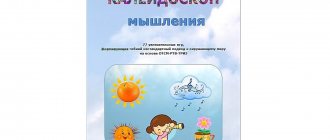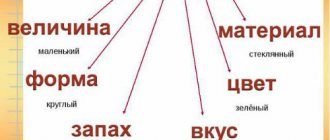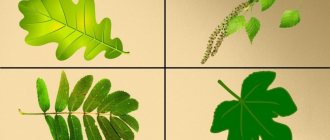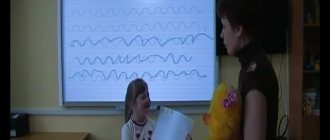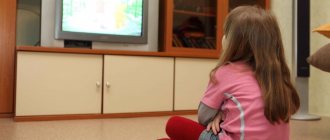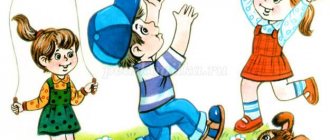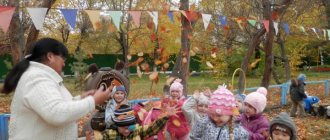TRIZ technologies in teaching drawing to children of middle preschool age
With the help of speech, the preschooler expresses his attitude towards his drawing, for example, its aesthetic assessment.
Speech gradually begins to control, plan and regulate the drawing process, helping the child to stimulate and realize the idea. The child draws what will happen, then names what is depicted in speech. To the question: “What are you drawing?” - answers: “I’ll draw it, then you’ll find out.” The appearance of the idea is due to the fact that speech moves from the end of the drawing process to its beginning and gives the preschooler the opportunity to determine in advance what he will draw. But defining the theme of the drawing is not enough for the idea to be created and realized. To implement a plan, it is necessary to highlight its content, select materials, outline the sequence of work, and evaluate the result from the point of view of how fully the plan is implemented.
The ideas of younger preschoolers are very unstable. External stimuli and difficulties that arise force the child to abandon the original goal.
The older preschooler not only states the result of drawing and formulates a plan, but also implements it. But without special training, children’s ideas, even at 5-7 years old, are often not detailed and develop as the image is created.
The implementation of a plan, in addition to the fact that it is determined by the ability to plan this process, is associated with the presence of complete ideas about the environment, as well as with the level of development of manual skill.
The implementation of a plan, independent finding of means for its implementation, a new original solution in creating an image characterize the manifestations of creativity in children's drawing.
At the same time, speech can negatively affect the originality of the drawing. Naming a figure with a certain word does not give the child the opportunity to visually analyze its outlines and encourages the repetition of a well-known graphic pattern, when a house is depicted as a connection of a square with a triangle on top.
As the child masters visual activity, an internal ideal plan of action is created, which is absent in early childhood. Therefore, it is important to note that the changes that occur in the child’s psyche during the drawing process are much more important than the drawing itself.
Drawing, reflecting the child’s knowledge and ideas about reality, at the same time helps him to master, is a means of cognition. Targeted teaching of visual arts will determine the content of children's drawings, which is determined by the gradual development of technical skills. For example, children of the third year of life draw paths and strings for balls, learning to draw straight lines. At the beginning of preschool age, the image of a person increasingly appears in drawings, which, apparently, is also associated with teaching moments. Until about 5 years of age, a child draws the same objects that adults taught him to depict. After 5 years, also with the help of an adult, children begin to overcome established patterns. Drawing for a long time, they create a huge number of drawings, reflecting everything that happens on land, in the air and at sea. The content of the drawings now includes plots from their favorite fairy tales, episodes from their own experiences, and samples seen in pictures and films. In a word, the same tendency is observed in drawing as in the development of play and writing: bizarre interweaving of the real and the fantastic. Continuation games appear, ongoing stories are invented and depicted. Favorite characters are depicted repeatedly in different situations, the child “arranges” their life, draws the events that happen to him.
Using TRIZ methods and techniques in the visual arts of preschool children
Municipal budgetary preschool educational institution
“Kindergarten of a combined type No. 11 “Olenenok”
Michurinsk, Tambov region
Compiled by the teacher
Provotorova Natalia Nikolaevna
Michurinsk-science city of the Russian Federation 2018
Visual activity is an artistic and creative activity. In the creative process, children reveal their abilities. But the use of traditional drawing methods does not allow us to fully achieve the desired result. Numerous non-traditional drawing techniques come to the rescue. Their uniqueness allows children to quickly and joyfully achieve the desired result. Children begin to believe in themselves, that they can express their ideas in a drawing, and solve a creative problem on their own. Non-traditional techniques contribute to the child’s interest, allow him to feel more relaxed and bolder. New techniques develop imagination and give freedom for self-expression. Many years of experience show that the use of non-traditional techniques increases the child’s creative potential in productive activities. But the teacher faces another huge task - to teach students to clearly express their thoughts.
TRIZ technology, adapted for preschool age, allows children to be taught under the motto “Creativity in everything.” As a result of using TRIZ technology, children’s cognitive activity increases, interest in the topic of the lesson, their horizons broaden, and an interest in novelty and imagination appears. Speech becomes figurative and logical not only in class, but also in everyday life. Such qualities of thinking as flexibility, mobility, systematicity, search activity, the desire for novelty of knowledge, speech and creative imagination develop. TRIZ methods and techniques cover many areas of educational and educational activities. They did not ignore the visual arts either. There are methods and techniques that are firmly embedded in the structure of classes and planning in fine arts, and there are those with which we can, if necessary, diversify children's activities.
The purpose of introducing TRIZ methods and techniques into children’s visual activities is to educate a creative, aesthetically developed personality capable of self-expression through various forms of artistic activity .
Main goals:
• To develop the qualities of a creative personality;
• Develop creative work skills, including the following components:
1. development of imagination,
2. originality of thinking,
3. the child’s ability to adapt to unexpected changes in the situation, the ability to reason and draw conclusions,
4. resourcefulness, attentiveness and intelligence;
TPF (typical fantasy techniques )
and RTV
(development of creative imagination)
• Revitalization. When we humanize natural objects.
For example, in a distant country there lived an evil wizard who really did not like people. One far from wonderful morning, he got tired of listening to people laughing, so he turned all the people into trees. You have the opportunity to disenchant them, but on the condition that you guess which person the wizard turned into which tree. Children look at pictures of trees and make guesses about which person and which tree was turned into. The oak tree appears to be a hero. Rowan is a fashionista because she dresses up in bright beads. The tree was called Cinderella because in life it is simple, but for the New Year it is dressed up like a princess.
The technique of getting used to the image . “If I were a creature from another planet...” Not only verbally convey the appearance and character of the character, but also depict it in a way that other children can understand.
Evil characters become good. "Baba Yaga invites you to visit." Invent and draw Koshchei the Immortal, Leshey, Vodyany and Baba Yaga as kind. Reception of entering the picture . What do you feel? How do you feel? What would you change?
Trying on an image on someone: “Mom is a fairy-tale heroine”, “Dad is a hero”, “People-animals”.
My mood. Non-objective drawing – we convey our mood with color.
Drawing emotions
Imagination games
1. “Magic pencil” (work in pairs)
Goal: to teach children to model a holistic image from chaotic signs. Develop a desire for group interaction.
Progress of the game:
Children try to draw a picture together. One of the pair draws (moves a pencil), and the second tells where to point the pencil. Rule: The pencil can only move up, down, left and right. Participants then guess the resulting images.
2. "How Animals See the World"
Goal: to teach children to shift their intellectual position in accordance with given conditions.
Progress of the game:
Children are invited to imagine themselves as some kind of animal and try to draw the world through the eyes of this animal.
3. "Creator"
Goal: to teach children to use unformed polysemantic material as elements of image construction .
Progress of the game:
Children are offered various materials (dry leaves, garbage, glitter, etc.) from which they need to make a picture and present it at an “exhibition.”
4. "Additional drawings"
Goal: to teach children to model a complete image based on a detail, part, or diagram.
Progress of the game:
Children are offered unfinished figures that they must complete.
5. "Unusual Portrait"
Goal: to teach children to model a graphic image in a constructive language.
Progress of the game:
Children are offered buttons of different colors and sizes, from which they can create any image they like.
6. Magic lines
Children find similarities between lines and objects and complete the drawing. Complication - to create a complete composition from many lines
One of the ways to develop imagination is to use non-standard drawing techniques
. It is important to teach children to experiment with various materials, teach them various imaging techniques for subsequent use in independent activities.
When organizing work on visual arts, you must follow the following rule - children should have the opportunity to choose
:
*visual material
(colored and simple pencils, watercolor, gouache, tempera, pastel, ink, charcoal, sanguine, crayons, wax candles, plasticine, clay, pebbles, shells, glue, various waste materials);
*material on which the image will be printed
: white and colored paper, velvet, patterned and plain fabric, cardboard, plywood, flat and round stones, plexiglass, PVC tiles, foil - all of different shapes and sizes.
All material must be in a place accessible to the child.
It is known that it is in free activity that a child’s personality develops more actively. Children draw with everything - with colored chalk on the asphalt, with sticks on damp sand, build figures from snow and sand and create beautiful decorations from natural materials. The children and I also come up with riddles on our walks.
In our future work, we will continue to use unconventional methods, materials and equipment.
Having done the work, I came to the conclusion that using TRIZ elements in art activities, the child not only reproduces what he sees, but also interprets and speculates his drawing in his own way. The use of TRIZ elements is the basis of developmental education; children’s feelings of constraint are relieved, shyness is overcome, and the logic of thinking gradually develops.
Examples of TRIZ tasks for schoolchildren and preschoolers
In this book you can find many interesting questions and tasks that can be discussed with kids. For example:
- Who is more, men or dads?
- What are more squares or quadrangles in the world?
Many of the TRIZ problems can be solved while walking or on the way home, if you casually ask your child about:
- Why does snow melt or what color is the water?
- Why do trees shed their leaves?
- Why do houses need windows?
I am sure any of these questions will force the child to reason, and most importantly, think!
The essence of the TRIZ method for preschoolers in general terms
The most important thing is to draw the child’s attention to interesting things, not to try to explain everything in the world and give it in a ready-made form, to look at the situation from different sides more often, to find the good in the “ bad ” and the bad in the “ good ,” think together, conduct experiments, but do not try to fully explain the results - in general, cultivate curiosity in preschoolers in all its manifestations. You can understand what I’m talking about by reading, for example, an article about what kind of association thinking games we came up with. For example, in the book “ Mathematics for Kids ” Zvonkin describes the idea of this approach very well, without saying anything at all about TRIZ . He simply intuitively restrained himself and did not give answers to the kids’ questions, did not indulge in tedious and spatial explanations of what was true and what was not. And he simply fell silent and, to his surprise, unanswered questions often gave better results than standard explanations. The children began to think and look for their own answers to difficult questions.
